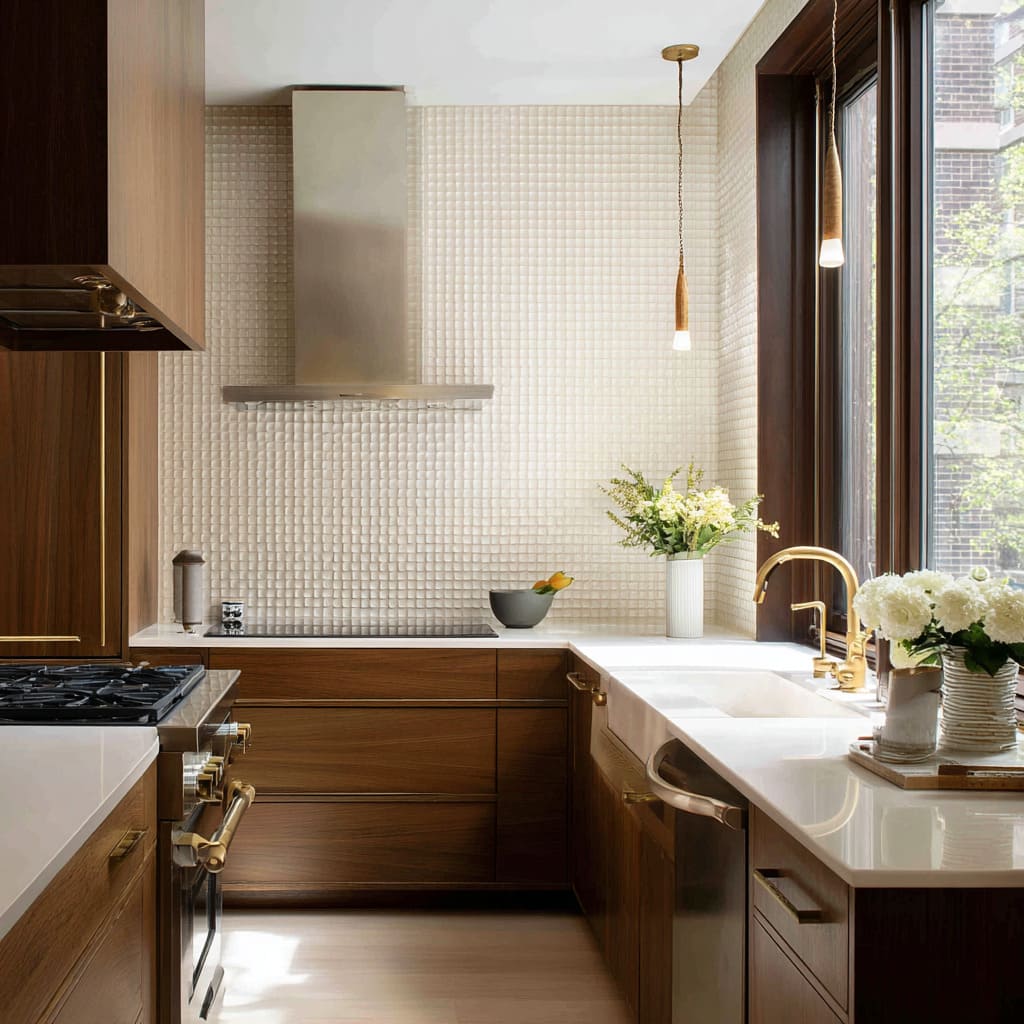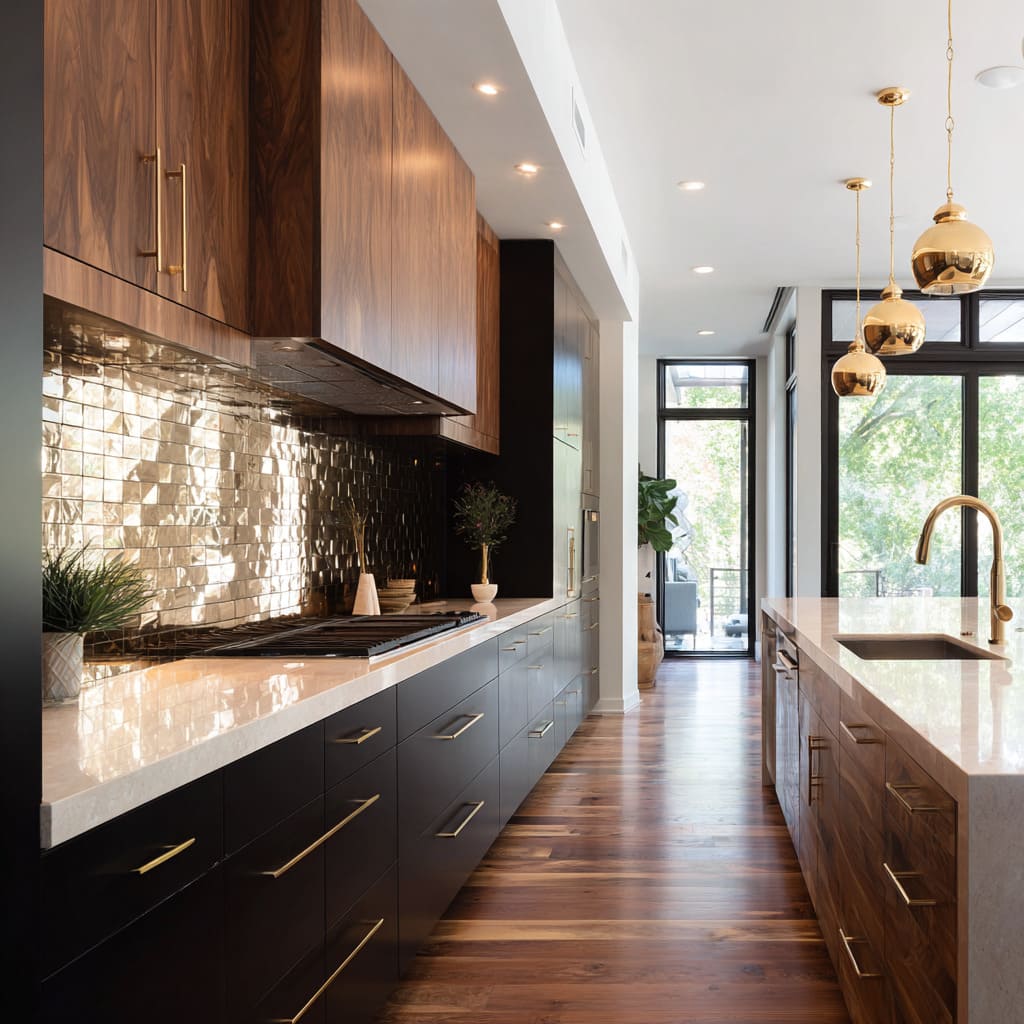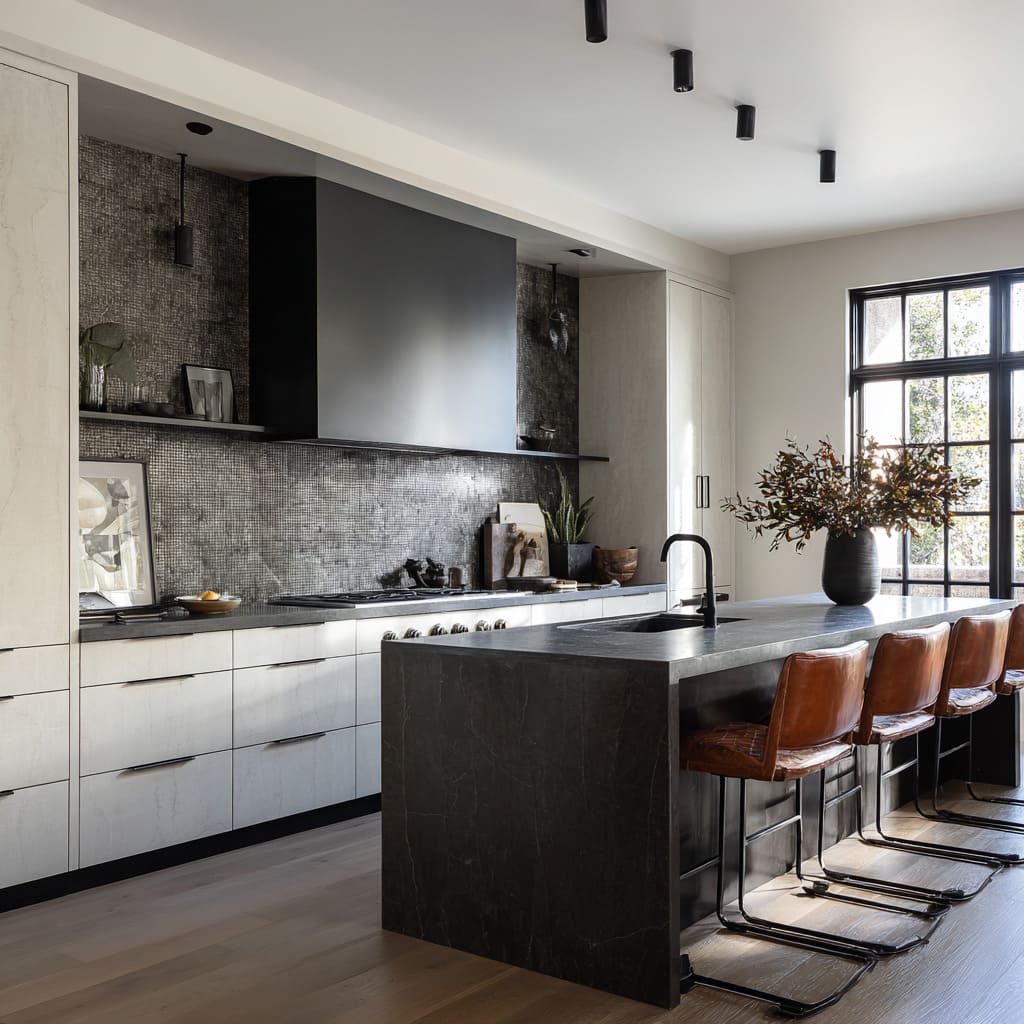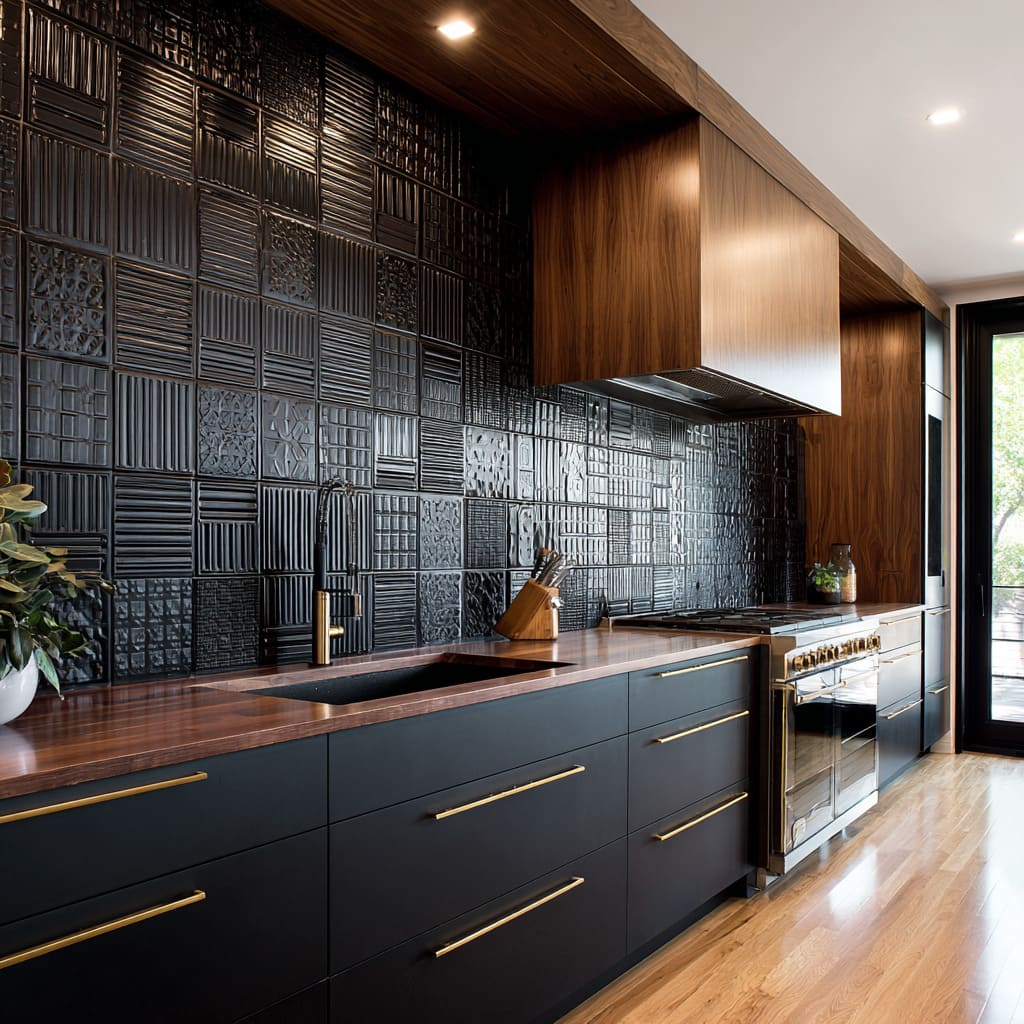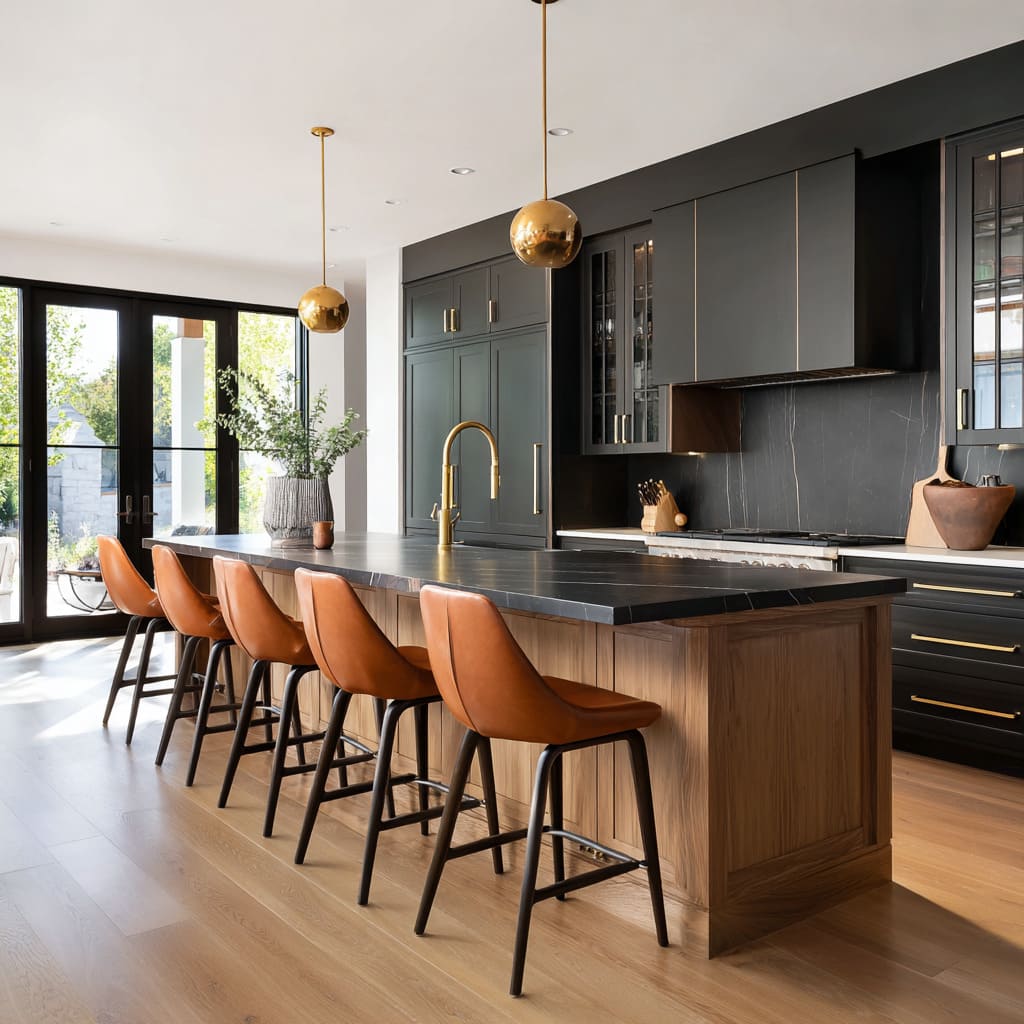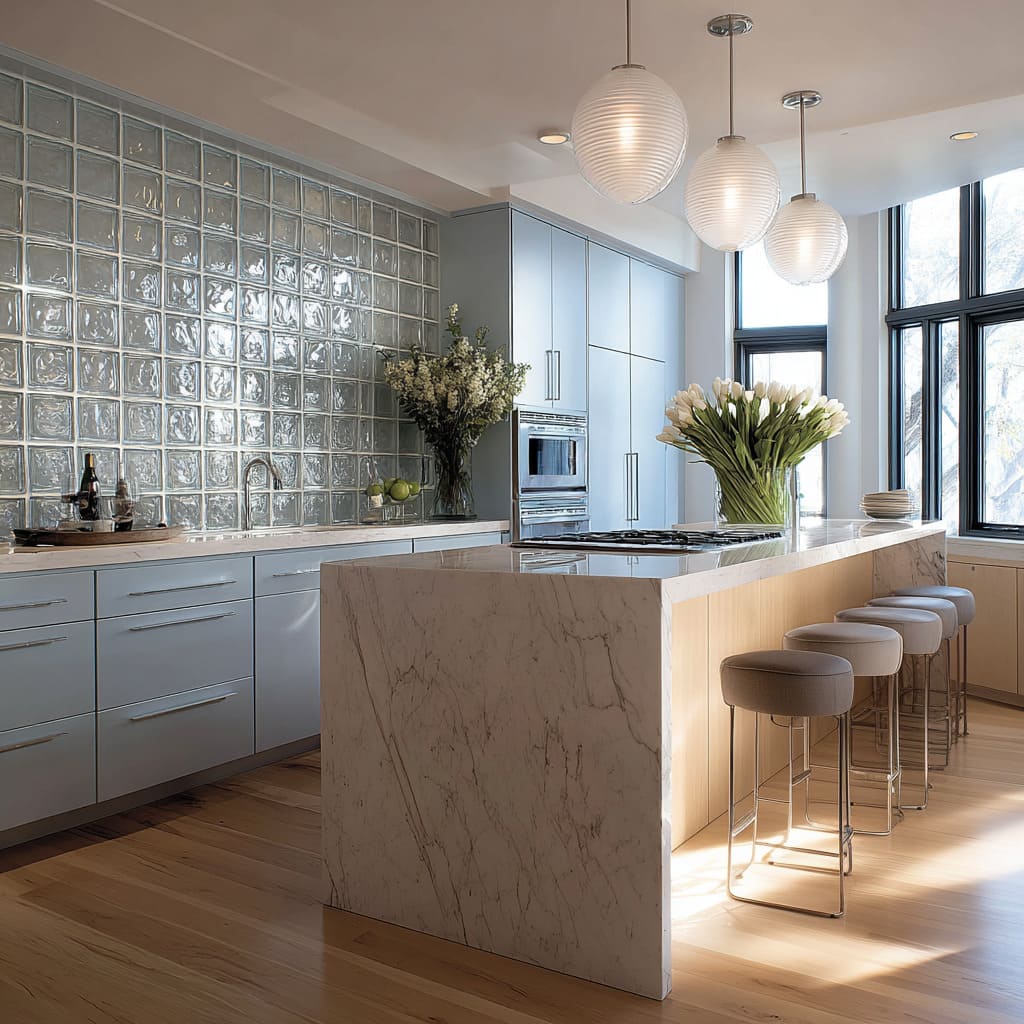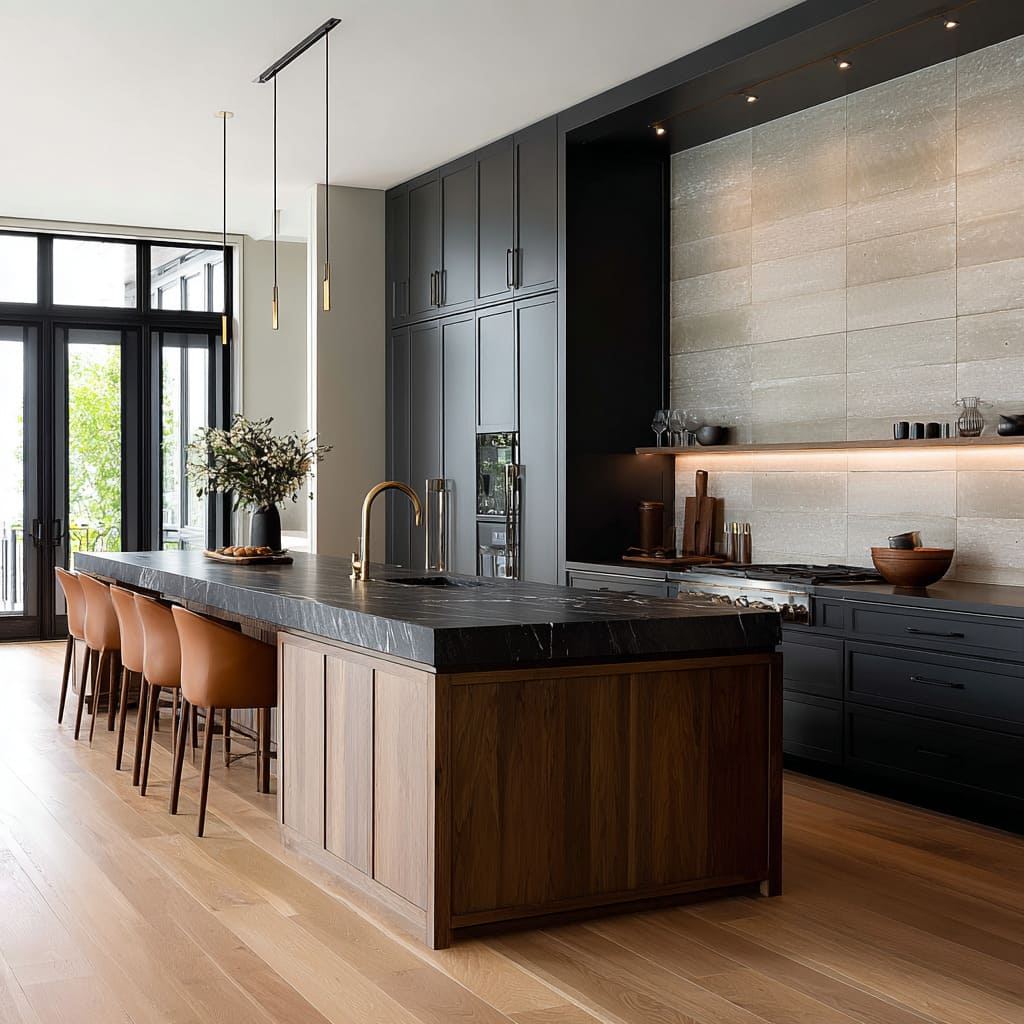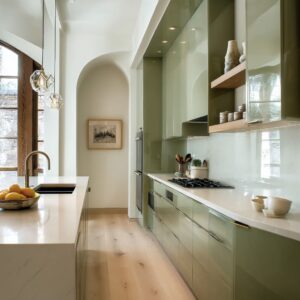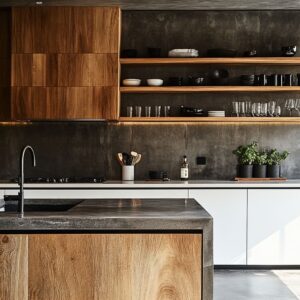In many contemporary interior designs, creative kitchen backsplash ideas treat the wall behind the cooktop and sink as the main view for the people sitting at the island, rather than a quiet strip of protection. The person at the range sees ingredients and pans; guests on the stools spend much more time looking at the backsplash.
This is why so many recent kitchen designs build large, calm “stone murals” behind stronger cabinetry and islands. Pale slabs in sandy grey, soft cream, or charcoal-veined stone sit inside dark frames of cabinetry and counters, almost like landscape paintings held inside millwork.
The eye reads long horizontal joints as gentle bands that echo floorboards or island proportions, so the room feels stretched and composed rather than chopped into tiles. In darker schemes, a mosaic field behaves like a night sky behind the activity of cooking: tiny squares in graphite and pewter absorb visual noise from jars, bottles, and utensils, so everyday objects merge into a single textured band.
From the island, this makes the kitchen feel more like a lounge or bar with a curated backdrop than a traditional working room lined with cupboards. The mood is shaped by proportion and tone: oversized stone panels create a sense of depth and calm; dense mosaics add intimacy and a touch of drama; full-height small tiles turn into a soft “fabric” for the eye.
In every case, the backsplash is treated almost like a cinema screen behind the island, controlling how serious, relaxed, bright, or cocoon-like the seating zone feels.
Scale and Texture as Design Language: From Stone Murals to Tile Fabrics
Among the most subtle creative backsplash ideas is the way designers use scale and texture instead of strong color. Large-format slabs and tiny modular tiles sit at opposite ends of the same strategy.
Broad stone sheets with very soft veining read as atmosphere rather than pattern; from several meters away they feel like a gentle mist of tone behind dark cabinets and a strong island. The absence of visible grout lines keeps the wall from fragmenting, so the kitchen length feels generous and calm, especially in open layouts where the cooking run is seen from a dining table or sofa.
On the other side, tiny tiles—penny rounds, pillowed squares, narrow mosaics—are chosen not for graphic impact but to create surfaces that resemble fabric or plaster. Grout colors sit very close to tile tones, so the wall behaves like a continuous skin covered in micro-relief; from a distance, this looks almost plain, but up close the eye starts to notice tiny domes, cushioned centers, or slight metallic flecks that catch light like threads in woven cloth.
Designers often play these scales against one another through material pairings:.
- Stone murals with flat cabinetry
- One large stone field in pale or dark tones
- Super-matte doors and drawers with minimal joints
- Handles treated as linear accents that echo stone veining
- Small tiles in very narrow tonal ranges
- Tiny squares mixing charcoal, brown, and muted bronze
- Dark uppers above, warm wood lowers below
- One thick shelf slicing through the middle to control the busy field
This way of thinking lets the backsplash hold enormous visual richness without feeling busy. Scale itself becomes a tool: big pieces for calm, small pieces for tactility, and the choice of grout and tonal range decides whether the wall reads as bold pattern or as a soft, intricate fabric behind the social life of the kitchen.
Light-Responsive Walls: Backsplashes as Quiet Light Instruments
In many of the most interesting designs, creative backsplash design treats light as a core ingredient, not an afterthought. Relief tiles, ribbed surfaces, split-face stone, faceted metals, and glass blocks are chosen for how they react when light grazes them from above, below, or the side.
A slim ledge with concealed lighting along the lower third of a stone wall can turn gentle veining into a hazy horizon at night, picking up every joint and subtle cloud in the surface. In vertical stone strips, a thick shelf with warm light underneath exaggerates each groove so the wall feels like a glowing stack of reeds.
Ribbed terracotta or clay-rose tiles become bands of moving shadow as daylight rakes them from a nearby opening, each flute catching highlight on one side and sinking into shadow on the other.
Different backsplash materials shape light in distinct ways:.
Glass and translucent surfaces
Glass block walls turn the sink zone into a panel of diluted daylight. Rather than clear views, the glass shows softened silhouettes and fractured reflections of windows and pendants.
The backsplash becomes a daylight filter: brighter blocks near the light source, slightly clouded blocks further away, small variations in each cavity. Paired with pale cabinetry and cool stone, this gives a sense of air and water without using literal nautical themes.
Metal and soft shine
Champagne or bronze metal mosaics create a more glamorous, bar-like mood along the cooking wall. Each small rectangle has a mildly angled face, so downlights above skim the surface and generate an intricate play of highlights.
The grout nearly disappears, and what remains is a liquid strip of reflection that feels animated even when the kitchen is still. When such walls are paired with matte walnut cabinets and dark drawers, long brass pulls and gold pendants over the island act as calm companions; they echo the color of the backsplash in broader, quieter shapes.
Sculpted stone and geometric relief
Geometric tiles with grooves running in different directions rely almost entirely on shadow and faint highlight. Warm metal outlines in certain joints act like drawn lines, emphasizing edges without strong color contrast.
As patterns fade upward into smoother tiles, the wall changes mood from intricate near the counter to quiet near the cabinets, and directional light makes the lower portion feel like a subtle mural in graphite and brass. Here, the backsplash operates almost like a light sculpture, tuning the character of the room through beam angle and grazing rather than through pigment.
Color as a Concentrated Band: Warm Spines in Neutral Kitchens
Some interiors express color through the backsplash as a single, concentrated “spine” within an otherwise quiet palette. In these schemes, cabinets, floors, and ceilings stay within off-whites, taupes, soft beiges, or smoky greys, while a long strip of tiles in terracotta, clay-rose, or multitone stone becomes the main source of warmth.
Slim vertical tiles in a rich earth tone, with fine ribs running from counter to upper cabinets, form a rectangular band behind the cooktop that reads like a scarf wrapped through a neutral outfit.
The rest of the room feels calm, but this band glows gently when light hits it, giving the kitchen an identifiable center of gravity. In other examples, vertical strips of stone in many shades—sand, honey, rust, misty grey—compose a full-height rug of mineral color that runs into corners and behind tall units.
A single shelf with lighting underneath pulls a stronger amber tone from the mid-zone, so the wall transitions from cool at the top to luminous near hand level.
Lists of finishes and objects are kept very controlled in such spaces: kettles, coffee machines, vases, and art pieces tend to share vertical proportions that mirror the direction of the tiles, and objects are chosen in materials that echo or gently counter the backsplash tone—stainless steel against terracotta, black ceramic against honey stone, a rust-colored pot against clay-rose ribs. Small repetitions of color appear on the island or dining table in bowls, textiles, or stools, but the backsplash remains the main carrier of hue.
This focus prevents the kitchen from feeling scattered; color expresses itself through one key plane that sits at the center of the visual field, especially for anyone seated at the island. The result is a type of color strategy where warmth is intense but controlled, set into one deliberately framed band that can switch the emotional reading of the entire space from cool and minimal to friendly and grounded.
Space-Shaping Surfaces: Wrapping, Height and Composed Layouts
Many creative backsplash ideas for kitchen layouts use wrapping, height variation, and careful stopping points to subtly change how a room feels without moving a single wall. Full-height tile from counter to ceiling softens the corners of compact kitchens, especially where small tiles or pillow-faced squares run continuously behind a hood, open shelving, and around a return wall.
Corners that might feel sharp in paint or plaster become gentle turns in a continuous textured envelope, which is particularly effective in narrow spaces with an island or peninsula where people sit very close to the working wall. Dark glossy tiles can make the working side recede; reflections show blurred shapes and light rather than hard detail, so the opposite island or curved bar comes forward visually and feels more welcoming as the “front” of the room.
Height plays a quiet but important role. In many examples, the most intensive pattern sits around the mid-zone of the wall: dense geometry, structured mosaics, or strongly ribbed strips cluster between the counter and a shelf or the underside of the cabinets, while the upper portion becomes smoother and calmer.
This aligns the highest concentration of visual energy with seated eye level at the island, so guests experience the richness directly while the ceiling remains quiet. The line where the backsplash stops is equally considered: sometimes it meets a full-height volume of white cabinetry with a sharp, clean vertical edge; sometimes it runs uninterrupted to a floor-to-ceiling pane of glass, surrendering instantly to the view outside.
These endings give the wall a strong sense of intention. Rather than fading out behind an appliance or a random side wall, the pattern reads as a planned field with clear limits, and the overall layout feels more composed even if the footprint is simple.
Living-Room Attitude: Timber Walls, Shelves and Collected Objects
Some of the most intriguing creative backsplash ideas for kitchen design lean toward living-room thinking, using timber walls, thick floating shelves, books, and art objects where older kitchens might have stopped at tile and under-cabinet lights. Narrow wood strips in multiple tones and depths, laid in staggered horizontal bands, form a surface closer to contemporary paneling than to rustic cladding.
Small changes in depth cast fine shadow lines, so the wall reads as a relief piece. Brass or metal sconces placed high on this surface send warm cones of light down the timber, turning the backsplash into something that feels curated and crafted.
Dark, super-matte cabinets and counters beneath keep their profiles extremely calm, acting as a base that allows the wood to show its full rhythm without competition from raised panels or ornate hardware.
Elsewhere, stone slabs are combined with long wooden shelves that stretch nearly the full run of the wall. Instead of strictly functional items, such shelves host ceramics, bowls, books, and plants, almost as if the kitchen wall were a section of a library or lounge.
The stone continues from counter up the wall, so the lower and middle zones behave like a single folded surface, while wood above and below turns into a frame. Track lights mounted to a soffit or ceiling beam wash objects and veining in a way usually seen in living spaces.
This approach blurs the line between “kitchen” and “sitting area” in open plans; the backsplash becomes a shared visual language that can be seen from sofas, dining tables, and terraces. The island seating then feels less like perching beside appliances and more like sitting at a bar embedded inside a larger, coherent interior.
The cooking wall still does its job but also behaves like a collected, artful surface that supports daily life in the wider room.
Dark, Atmospheric Backsplashes and the Island as a Warm Counterpart
In many designs, the most atmospheric zones appear where dark backsplashes meet warm wood islands and brass elements. Small charcoal mosaics, deep graphite squares with micro-patterns, or near-black stone slabs with delicate veining absorb light and visual noise, helping everyday items fade into a single shadowy band.
This does not only create drama; it also offers a kind of visual tidiness. Bottles, jars, and cooking tools become part of a unified texture instead of standing out as individual fragments.
In some kitchen design concepts, each square tile carries a different relief—ribs, crosshatches, small dots—so the wall becomes a subtle tapestry where textures shift from tile to tile even though everything shares the same matte black tone. Under grazing light from ceiling spots or from one side window, some squares catch a soft sheen and others fall back, giving movement without changing any color.
Against these dark planes, islands often appear in walnut, oak, or warm stone, paired with leather or fabric stools that introduce tactility at seating level. Brass faucets on the island echo the warm pulls on base cabinets beneath the dark backsplash, and globe pendants above the counter pick up the tones of metal mosaics or dark stone in faint reflections.
The composition sets up a clear relationship: the cooking wall holds depth and mystery; the island offers touch, comfort, and sociability. This dynamic works well in open layouts where the kitchen is visible from multiple angles.
From a distance, the eye reads the dark backsplash as a steady vertical anchor and the island as the welcoming horizontal element where daily life gathers. Together they show how a backsplash can carry the mood of a room without relying on bright color, using tone, reflection, relief, and contrast with the seating block to create spaces that feel refined, intimate, and quietly expressive.


